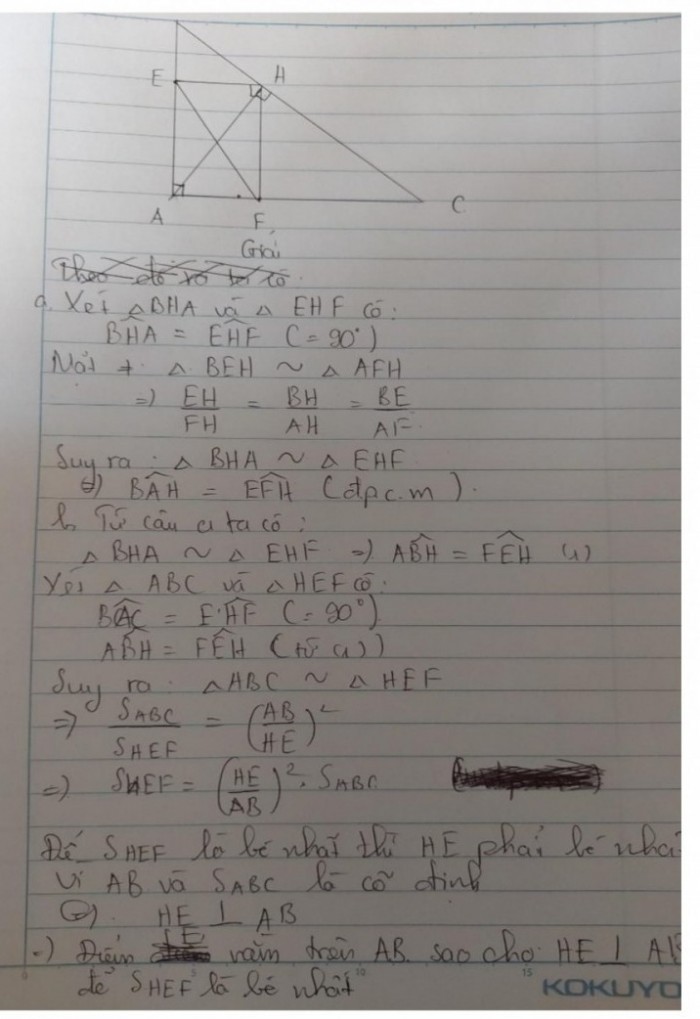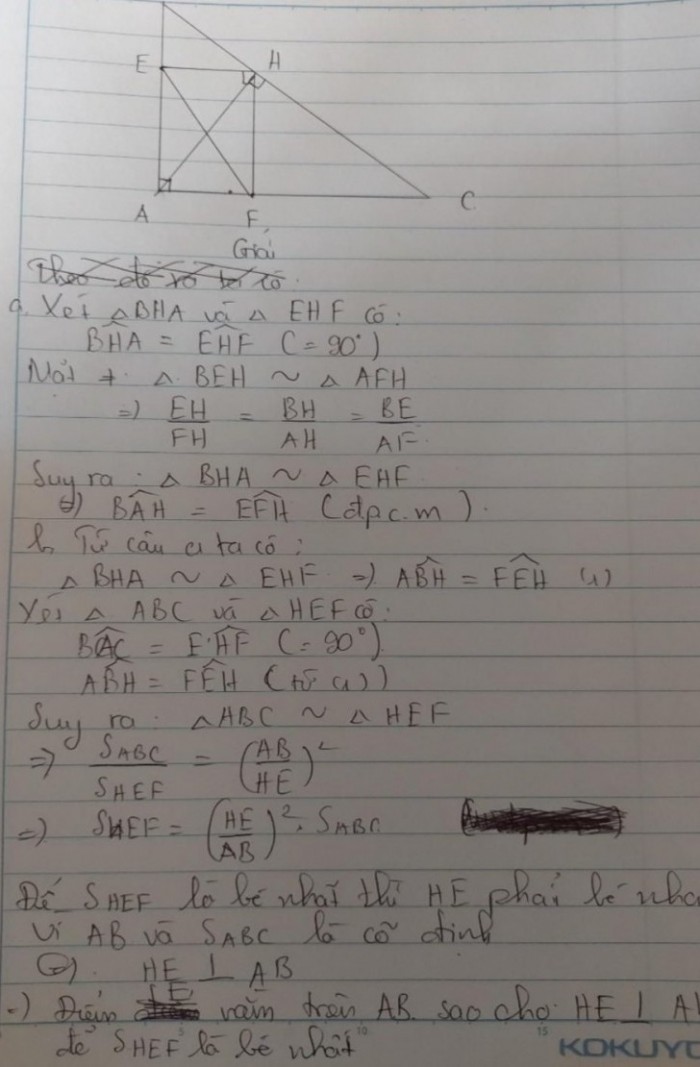a) Ta có tam giác BEH đồng dạng với tam giác AFH, do đó tỉ số đồng dạng giữa chúng là:
$\frac{BE}{AF}=\frac{BH}{AH}$
Vì tam giác ABC vuông tại A nên $AH=AB\cos B$ và $BH=AB\sin B$, thay vào tỉ số đồng dạng ta có:
$\frac{BE}{AF}=\frac{\sin B}{\cos B}=\tan B$
Do đó $\angle BEH=\angle AFH=B$.
Gọi $\angle BAH=\alpha$ và $\angle EFH=\beta$, ta cần chứng minh $\alpha=\beta$.
Ta có $\angle BAH=\angle BEH+\angle HEA=\angle BEH+\angle HFA=\angle BEH+\angle AFH=B+\beta$.
Vậy $\alpha=B+\beta$, suy ra $\alpha-\beta=B$.
Do đó góc BAH bằng góc EFH.
b) Để diện tích tam giác HEF đạt giá trị nhỏ nhất, ta cần xác định vị trí của điểm E trên cạnh AB sao cho đường cao AH chia tam giác ABC thành hai tam giác có diện tích bằng nhau.
Gọi x là độ dài của AE. Khi đó, độ dài của EB là AB - x.
Diện tích tam giác ABC là $\frac{1}{2}AB\cdot AC=\frac{1}{2}AB\cdot (AH+HC)=\frac{1}{2}AB^2\sin C+\frac{1}{2}AB^2\cos C=\frac{1}{2}AB^2(\sin C+\cos C)$.
Diện tích của tam giác AHE là $\frac{1}{2}AH\cdot AE=\frac{1}{2}AB\cos B\cdot x=\frac{1}{2}AB^2\cos B\cdot \frac{x}{AB}=\frac{1}{2}AB^2\cos B\cdot \sin B$.
Diện tích của tam giác EHC là $\frac{1}{2}HC\cdot EB=\frac{1}{2}AB\sin B\cdot (AB-x)=\frac{1}{2}AB^2\sin B-\frac{1}{2}AB^2\sin B\cdot \frac{x}{AB}=\frac{1}{2}AB^2\sin B-\frac{1}{2}AB^2\sin B\cdot \cos B$.
Để diện tích tam giác HEF đạt giá trị nhỏ nhất, ta cần có $\frac{1}{2}AB^2(\sin C+\cos C)=\frac{1}{2}AB^2\cos B\cdot \sin B+\frac{1}{2}AB^2\sin B-\frac{1}{2}AB^2\sin B\cdot \cos B$.
Simplifying this equation, we get $\sin C+\cos C=\cos B\cdot \sin B+\sin B-\sin B\cdot \cos B$.
Using the trigonometric identity $\sin C+\cos C=\sqrt{2}\sin\left(C+\frac{\pi}{4}\right)$ and $\cos B\cdot \sin B+\sin B-\sin B\cdot \cos B=\sin B+\cos B\sin B-\sin B\cos B=\sin B(1+\cos B)$, we have $\sqrt{2}\sin\left(C+\frac{\pi}{4}\right)=\sin B(1+\cos B)$.
Since $\sin\left(C+\frac{\pi}{4}\right)$ and $\sin B$ are both positive, we can square both sides of the equation to get $2\sin^2\left(C+\frac{\pi}{4}\right)=\sin^2 B(1+\cos B)^2$.
Using the trigonometric identity $\sin^2\theta=\frac{1-\cos(2\theta)}{2}$, we can rewrite the equation as $1-\cos\left(2\left(C+\frac{\pi}{4}\right)\right)=\frac{1-\cos B}{2}(1+\cos B)^2$.
Simplifying this equation, we get $\cos\left(2\left(C+\frac{\pi}{4}\right)\right)=1-\frac{1-\cos B}{2}(1+\cos B)^2$.
Since $C+\frac{\pi}{4}$ and $B$ are acute angles, we have $2\left(C+\frac{\pi}{4}\right)<\pi$ and $0
Therefore, the right-hand side of the equation is positive, which means the left-hand side must also be positive.
This implies that $2\left(C+\frac{\pi}{4}\right)<\pi$, which gives $C<\frac{\pi}{2}-\frac{\pi}{4}=\frac{\pi}{4}$.
Since $C$ is an acute angle, we have $C<\frac{\pi}{4}$.
Therefore, the equation $\sqrt{2}\sin\left(C+\frac{\pi}{4}\right)=\sin B(1+\cos B)$ holds if and only if $C<\frac{\pi}{4}$.
In other words, the area of triangle $HEF$ is minimized when $C<\frac{\pi}{4}$.
This means that the point $E$ must be located on the side $AB$ such that $AETherefore, the point $E$ must be located on the segment $AB$ rather than on the extension of $AB$.Trang chủ
Giải bài tập Online
Đấu trường tri thức
Dịch thuật
Flashcard - Học & Chơi
Cộng đồng
Trắc nghiệm tri thức
Khảo sát ý kiến
Hỏi đáp tổng hợp
Đố vui
Đuổi hình bắt chữ
Quà tặng và trang trí
Truyện
Thơ văn danh ngôn
Xem lịch
Ca dao tục ngữ
Xem ảnh
Bản tin hướng nghiệp
Chia sẻ hàng ngày
Bảng xếp hạng
Bảng Huy hiệu
LIVE trực tuyến
Đề thi, kiểm tra, tài liệu học tập









 Trả lời nhanh trong
Trả lời nhanh trong 



 Xem thêm
Xem thêm  Thưởng th.12.2024
Thưởng th.12.2024 Bảng xếp hạng
Bảng xếp hạng